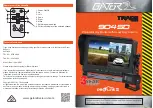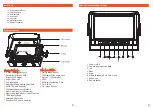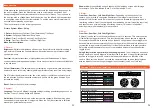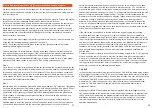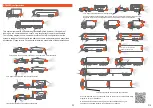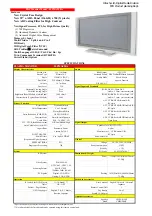
How to find reversing wires to trigger or power backup camera systems.
We recommend that you wire up the triggers as the last part of your installation (after the
systems monitor has been wired) this is so that you can use the system as a safe way to test
for a reversing wire.
Back up camera systems (reversing camera systems) require a signal to “Trigger” the system
into action so that it automatically operates when the vehicle is in reverse.
Whilst some systems are designed to allow cameras to operate even when the vehicle is not
in reverse it is still necessary to wire a trigger system in so that the Camera that is facing
backward automatically turns and or takes over as priority when in the vehicle is in reverse.
When wired in correctly using the right trigger priority, the system can also automatically turn
on the rear camera of an attached trailer taking priority over the vehicles back up camera
when the trailer is connected.
The most common way to trigger the rear facing camera is to use the + wire that powers one
of the vehicles reversing globes at the back of the vehicle.
NOTE: Some vehicles that Use CAN bus to operate rear lighting systems may require
additional parts to trigger the system.
Caution: Never test for reversing wires standing at the back of the vehicle, with the engine
running and the gearbox in reverse gear. If the car/truck can not be placed in reverse without
the engine running, Special procedures should be employed. In this case we highly
recommend you seek a professional installer to do this type of work. Failure to follow proper
procedure could cause serious injury or death. (The vehicle could back over you)
Step 1.
Place the car in reverse, with ignition on but the car not running (do not leave the cars ignition
on for long periods of time without starting it) observe or have an observer notice which light
turns on and its location in the lens. Turn the ignition off. Then, locate the globe socket that
holds the reversing globe into the lens. In some cases the Lens has to be removed from the
car to expose the socket. In most cases however, you can gain access from the inside of the
car behind a removable interior wall/panel.
Step 2.
Identify which wire is the globes ground and which is positive (see Fig 1 diagram). Light globes
have very low resistance so if a globe is in place, both wires will show up as a ground. Even if
you remove the globe the second globe on the other side of the vehicle will still give the
positive side a short path to ground and may still be indistinguishable from the globes earth.
For this reason it is necessary to energize the globe to find out which side is positive and
which side is negative.
Using a multimeter set to DC volts (make sure that it is on the correct scale) attach the
negative probe to one of the globes wires and the positive probe to the other (in most cases
you can push the probe ends into the back of the globe socket) if not, you may have to
carefully strip both wires sheaths back to expose the wires core making sure you keep
them separate and away from the cars chassis to avoid any shorts). You should also
make sure the globe it self is not resting on something that could be harmed by extreme
heat as the globe when on can get very hot). Turn the ignition back on again with the cars
gear set to reverse (without the engine running). The globe should illuminate and the
multimeter will show a positive voltage or a negative voltage across the globe. By noting
whether the voltage is positive or negative you can define which wire is positive or
negative. If the reading is positive then the probes positive is connected to the positive
wire. If it’s a negative reading then the multimeter's negative probe is connected to the
positive wire of the globe as a final check, take the vehicle out of reverse with the ignition
still on and check that the voltage is now zero.
If the vehicle can not be placed in reverse without the engine running the following
procedure should be used. With the car off, remove the globe. Set your multimeter to
resistance on the lowest setting. Place one probe on a part of the chassis that is ground
(most rear tail light assemblies have a small grounding screw close by). If you can not find
one look for some exposed chassis (like a tailgate hinge etc). Measure the resistance to
ground of both wires in the back of the globe socket (with the globe out) whist the
resistance will be very similar (because of the other globe still in the circuit) one wire will
have a slightly higher resistance. The one with the highest resistance should be the
positive wire.
Connect the system to this wire and then use the reversing system to test if it is triggering.
With no one at the rear of the vehicle. Start the car. Make sure the reversing systems
monitor is in the off state and then place the vehicle in reverse. If you have found the
correct wire the system will automatically turn on from its off state. If you have connected
the trigger to the globes earth no harm is caused but the system will not trigger. In that
case simply connect it to the alternate wire and repeat.
CAN BUS
In the event that the cars reversing lights are driven by CAN BUS the above wiring system
may not trigger the system correctly. It may even create a globe fault warning. In this case
a CAN BUS module (sold separately) may need to be installed. However, just because the
vehicle has a CAN BUS system does not necessarily mean that it will require such a
module to work. In fact the opposite is true. Most vehicles do not require an additional
module. If a CAN BUS module is required we recommend seeking advice from a
professional installer.
Multi trigger systems. Please refer to the diagram provided with trailer trigger systems.
Pay special attention to the AV camera numbers and trigger numbers. It is important that
the AV camera numbers match the diagrams placement in order to provide the correct
priorities so that when a trailer is connected it takes rear view priority over the vehicles
rear view camera and so that when no trailer is connected the vehicles rear camera
operates automatically.
P7
P8

